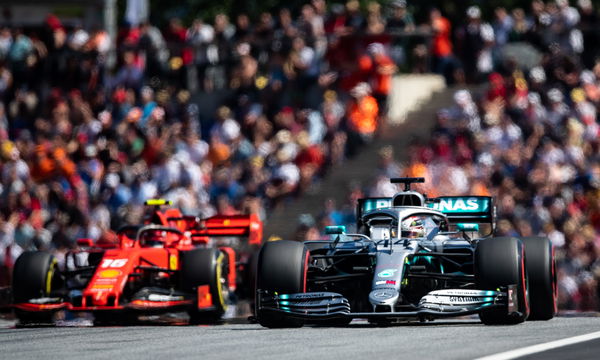
via Getty
SPIELBERG, AUSTRIA: Lewis Hamilton of Great Britain driving the (44) Mercedes AMG Petronas F1 Team Mercedes W10 leads Charles Leclerc of Monaco driving the (16) Scuderia Ferrari SF90 on track during qualifying for the F1 Grand Prix of Austria at Red Bull Ring in Spielberg, Austria. (Photo by Lars Baron/Getty Images)

via Getty
SPIELBERG, AUSTRIA: Lewis Hamilton of Great Britain driving the (44) Mercedes AMG Petronas F1 Team Mercedes W10 leads Charles Leclerc of Monaco driving the (16) Scuderia Ferrari SF90 on track during qualifying for the F1 Grand Prix of Austria at Red Bull Ring in Spielberg, Austria. (Photo by Lars Baron/Getty Images)
F1 is a notoriously dangerous sport. It always has been. Every driver who participates in it, risks his life day in and day out.
Since its inaugural season in 1950, the sport of F1 has evolved over many decades and also in a variety of ways. The most telling and notable aspect of this evolution has been the cars, or rather to put it more specifically, the safety of the cars.
Over the years, the organizers of F1 have grown to realize the hazards of driving a metal trap at speeds of over 300 km/h. Some of these realizations have occurred due to unfortunate and painful fatalities. Through time, however, the sport has definitely gotten a lot safer.
ADVERTISEMENT
Article continues below this ad
But to what extent has it gotten safer? Is there still risk involved? Does it still pose danger?
Let’s attempt to answer these questions.
Also Read: Key Details You May Have Missed in Lewis Hamilton’s Mercedes F1 Contract Confirmation
How many driver deaths have occurred in F1 in the last two decades?
This is one stat that offers a high degree of proof regarding the safety of the sports in the current day and age. Since the year 2000, Jules Bianchi is the only F1 driver to have passed away due to a crash.
In contrast, during the first three decades of the sport, a total of 28(!) drivers had succumbed to their injuries.
One could argue that this metric by itself doesn’t take into account the several high-profile accidents that have occurred where drivers have survived. But the counter to that point is the fact that they survived shows just how safe the sport has become at this point in time.
This leads us to our next point.
Also Read: Everything You Need to Know About Helmet Visors and How They Work in the Rain
What has F1 done to make the sport safer? Have they learned from history?
The current iteration of the FIA has taken safety very seriously. The greatest measure that F1 has taken in recent times regarding driver safety is the introduction of the Halo.

via Reuters
Formula One F1 – Sakhir Grand Prix – Bahrain International Circuit, Sakhir, Bahrain – Mercedes’ George Russell leads and Valtteri Bottas is second placed after the start of the race Pool via REUTERS/Hamad I Mohammed
The Halo was introduced as a direct result of Bianchi’s horror crash. Surprisingly, there were a large number of people, including drivers, who didn’t like the idea of the Halo, but this ideology gradually changed. One needs to only look back at Romain Grosjean’s crash in Bahrain and the immediate aftermath.
Everyone including Grosjean himself thanked the Halo. The Frenchman said, “It’s the greatest thing in Formula 1. Without it, I wouldn’t be talking to you now.”
Apart from the Halo, there have been several other considerations made for the safety of drivers – the introduction of gravel traps, run off areas, axing/modifying of circuits that were deemed too dangerous (a direct result of Ayrton Senna‘s death), and the placing of Aramco barriers, among others.
Moreover, the FIA has been increasingly concerned with weather interruptions too. Back in the old days, even heavy rain couldn’t hold up the race. But nowadays, any sort of standing water on the track is properly scrutinized before the green light can be given. Drivers are also encouraged to raise any concerns at the race debriefing sessions too.
Even the tires have been made safer with the current iterations of tires being broader and offering more grip. To reduce tire punctures, a new set of tires are being introduced for 2021.
ADVERTISEMENT
Article continues below this ad
The final verdict?
As things stand, the sport is as safe as it has ever been. F1, at the moment, sets the standards for safety in motorsport and is living up to it.
But does that mean that there is no risk involved? Would there be no fatal accidents from now on?
ADVERTISEMENT
Article continues below this ad
The answer to that is no. Unfortunately, the sport in its very essence involves a ridiculous amount of risk. There can be freak accidents where a driver loses his life (Anthoine Hubert’s F2 crash).
So, in the end F1 is still dangerous yet is still as safe as it could possibly be. Make of that what you will.
ADVERTISEMENT
ADVERTISEMENT
ADVERTISEMENT
ADVERTISEMENT

